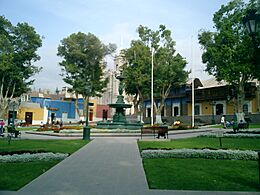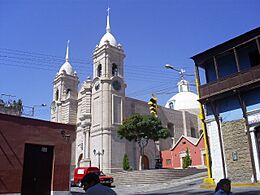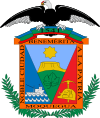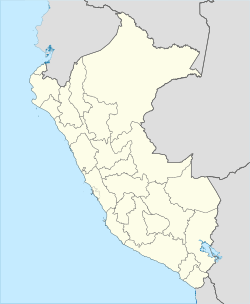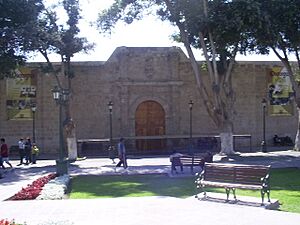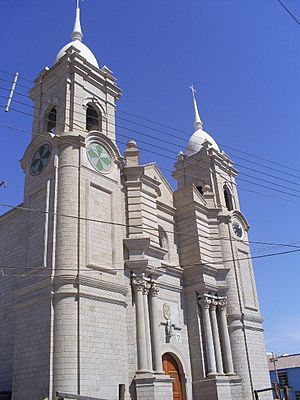Moquegua facts for kids
Quick facts for kids
Moquegua
|
|||
|---|---|---|---|
|
City
|
|||
|
From the top: Main square, NorVill winery, View of Moquegua, 25 November stadium, Old matrix church and Santo Domingo complex
|
|||
|
|||
| Country | |||
| Department | Moquegua | ||
| Province | Mariscal Nieto | ||
| District | Moquegua | ||
| Area | |||
| • Total | 3,949 km2 (1,525 sq mi) | ||
| Elevation | 1,410 m (4,630 ft) | ||
| Population
(2017)
|
|||
| • Total | 69,882 | ||
| • Estimate
(2015)
|
60,572 | ||
| • Density | 17.6961/km2 (45.833/sq mi) | ||
| Demonym(s) | Moqueguano/a | ||
| Time zone | UTC-5 (PET) | ||
| Postal code |
18001
|
||
Moquegua is a city in southern Peru. It is the capital of the Department of Moquegua, Mariscal Nieto Province, and Moquegua District. The city is located about 1144 kilometers south of Lima, Peru's capital. Spanish settlers founded it long ago, giving it a very long original name: Villa de Santa Catalina de Guadalcázar del Valle de Moquegua.
Contents
History of Moquegua
The Moquegua region has been home to different groups of indigenous peoples for thousands of years. The Wari culture built many important sites here. They also created special terraced fields on hillsides. This helped them grow crops long before the Inca people arrived.
One famous Wari site is Cerro Baúl. It is a monumental ruin on top of a hill near Moquegua. The area also has many sites from the Tiwanaku culture. This valley is special because it has ruins from both the Wari and Tiwanaku cultures.
The Chiribaya culture also lived in the Moquegua area. They thrived near the Pacific coast from about the year 1000 to 1360.
Later, in the 15th century, the Inca Empire expanded into this region. The Inca Emperor Mayta Cápac led a military group that reached the Pacific coast. However, in the next century, the Spanish arrived and took control.
The exact year the Spanish founded the city is not fully known. But, many people believe the colonial city was started on November 25, 1541. It is said that Pedro Cansino and his wife Josefina de Bilbao were the founders.
Geography and Climate
Moquegua's Weather
Moquegua is located in the mountains. The city has a warm and dry climate for most of the year. It gets very little rain, especially from April to November. The temperatures are usually pleasant, making it a comfortable place to visit.
| Climate data for Moquegua, elevation 1,420 m (4,660 ft), (1991–2020) | |||||||||||||
|---|---|---|---|---|---|---|---|---|---|---|---|---|---|
| Month | Jan | Feb | Mar | Apr | May | Jun | Jul | Aug | Sep | Oct | Nov | Dec | Year |
| Mean daily maximum °C (°F) | 27.0 (80.6) |
27.1 (80.8) |
27.4 (81.3) |
26.8 (80.2) |
26.7 (80.1) |
26.4 (79.5) |
26.5 (79.7) |
27.1 (80.8) |
27.3 (81.1) |
27.4 (81.3) |
27.3 (81.1) |
27.2 (81.0) |
27.0 (80.6) |
| Mean daily minimum °C (°F) | 13.2 (55.8) |
13.7 (56.7) |
13.3 (55.9) |
11.8 (53.2) |
10.4 (50.7) |
9.6 (49.3) |
9.5 (49.1) |
9.9 (49.8) |
10.3 (50.5) |
10.7 (51.3) |
11.1 (52.0) |
12.2 (54.0) |
11.3 (52.4) |
| Average precipitation mm (inches) | 6.3 (0.25) |
6.9 (0.27) |
2.8 (0.11) |
0.2 (0.01) |
0.0 (0.0) |
0.0 (0.0) |
0.1 (0.00) |
0.0 (0.0) |
0.0 (0.0) |
0.0 (0.0) |
0.0 (0.0) |
0.9 (0.04) |
17.2 (0.68) |
| Source: National Meteorology and Hydrology Service of Peru | |||||||||||||
Things to See in Moquegua
Moquegua is a popular place to visit in Peru. It has many beautiful gardens and other interesting sights.
- Plaza de Armas: This is the main square in the center of the city. It was designed in the 1800s by Gustave Eiffel. He was a famous French architect who also designed the Eiffel Tower in Paris. You can find the Jose Carlos Mariategui Museum and the Contisuyo Museum here.
- Casa del Regidor Perpetuo de la Ciudad: This old house was built in the 18th century. It has a beautiful front made of carved stone. Today, it is a museum where you can see old furniture and antiques.
- Torata District: About 24 kilometers from the city, you'll find the district of Torata. It has traditional houses with special mojinete roofs. The local church also has lovely wood carvings.
The Pan-American Highway passes through Moquegua, making it easy to reach.
Economy of Moquegua
The economy of Moquegua mostly depends on mining. The region has valuable resources like copper, silver, gold, and molybdenum. Large copper mines, such as Cuajone and parts of Toquepala Mine, are located in the Mariscal Nieto Province. There is also a facility in Ilo province that processes copper from these mines.
See also
 In Spanish: Moquegua para niños
In Spanish: Moquegua para niños


